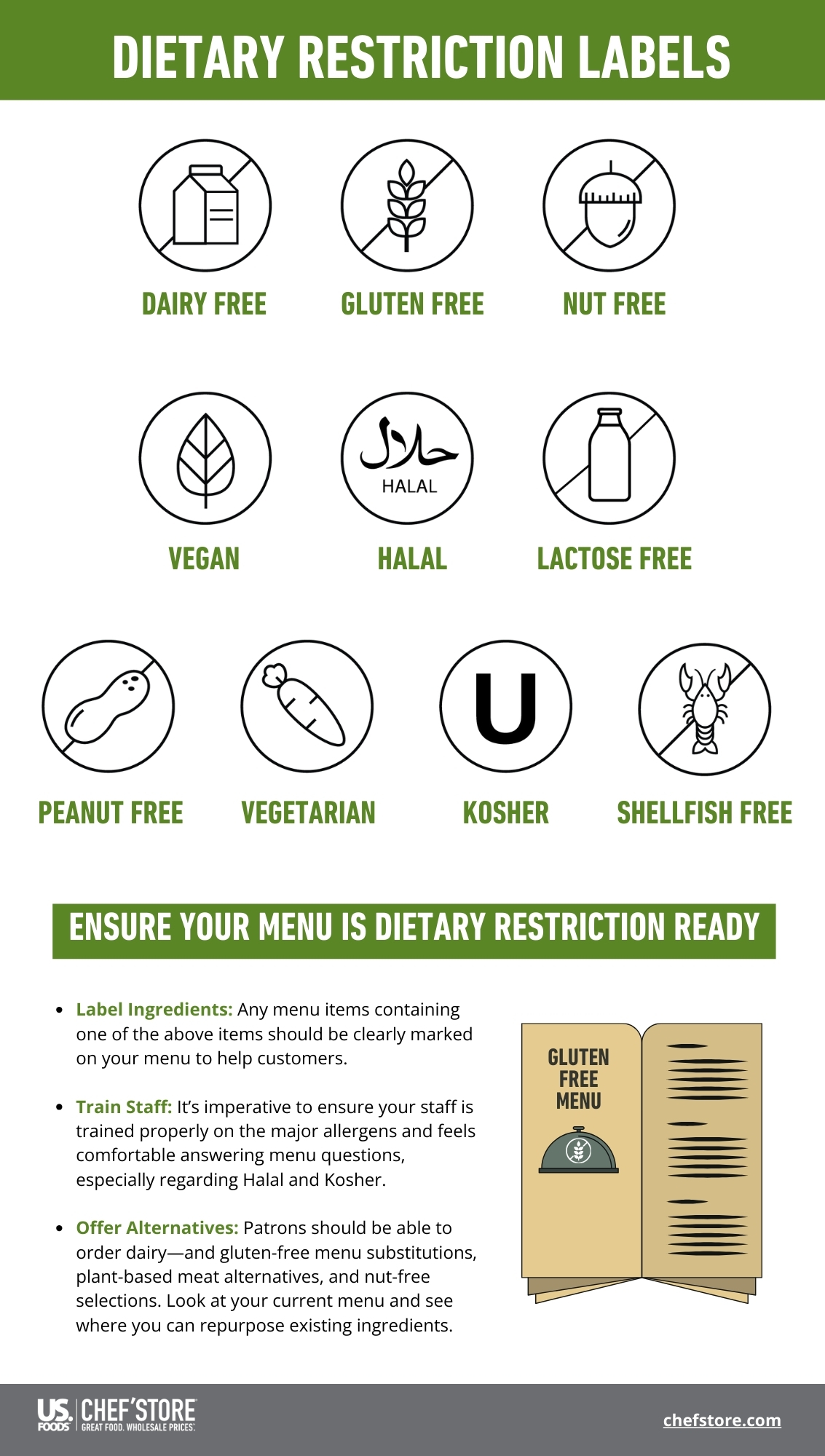
|
Navigating Dietary Restrictions in Your Restaurant
April 26, 2024

Dietary restrictions refer to any ingredient or food item a person can’t consume due to allergies, religious practices, health concerns, or personal morals. For example, one customer might be sensitive to dairy, while another might avoid animal-based dairy and follow a plant-based diet.
For restaurants, it’s essential to recognize that dietary restrictions don’t always mean someone is allergic, but all restrictions should be treated as important for every guest. The first step to accommodating guests with dietary restrictions is understanding what they are, where they come from, and the current restrictions landscape.
6 Of The Most Common Dietary Restrictions
Here are the most common ingredients customers might avoid or ask your restaurant staff about:
1. Dairy and Lactose
Lactose-free diners tend to be sensitive to lactose, a carbohydrate in milk solids. Lactose-intolerant diners may be able to tolerate certain dairy-based foods like yogurt and other fermented dairy products, butter, and aged hard cheese.
Dairy-free customers differ from lactose-free in that they don’t eat any products made from dairy, including butter, cheese, and fermented dairy ingredients.
Consumer Facts: Nearly 65% of the adult population has some form of lactose intolerance.
2. Gluten
Celiac disease, gluten sensitivity, and health choices are why gluten has become an increasingly commonplace dietary restriction. Gluten-free diners forgo any foods that contain wheat, barley, and rye. They’ll look to gluten-free bread or lettuce as a supplementary ingredient.
Consumer Facts: About 3.1 million Americans avoid gluten.
3. Peanuts and Tree Nuts
Peanut and tree nut allergies are prevalent and can cause severe reactions to anyone with the allergy. However, there are quite a few substitutions you can utilize to keep nuts either off your menu entirely or as a nut- and peanut-free option.
Sesame seeds can be used in everything from pesto to romesco and provide that delicious nutty flavor and texture. Pepitas are a great alternative and provide a delightful crunch to Pad Thai.
Consumer Facts: 6 million Americans have a sensitivity to peanuts and 30 percent of people with peanut allergies also have an allergy to tree nuts.
4. Vegetarianism and Veganism
There are many reasons why people elect a meat-free lifestyle. For some, it might be for health reasons; for others, it might be a way to bolster sustainable practices. No matter why a consumer chooses a more plant-based lifestyle, there are a few key factors to remember.
Vegetarians will consume dairy and eggs, but steer clear of other animal-based products. Vegans adopt a purely plant-based diet. This means no dairy, eggs, and, in some cases, honey.
Consumer Facts: There are over 13.4 million vegans in America and 1.5 billion people globally eat vegetarian.
5. Religious-Based Diets
Religion plays a large part in consumers’ eating habits and should be considered when a restaurant develops a well-rounded menu. There are a wealth of religions with their own particular rules regarding food. However, a few of the most popular are:
- Kosher: Kosher foods, part of the Jewish dietary law, are divided into three groups: meat, dairy, and neutral (also known as pareve). Kosher eaters cannot mix dairy with meat products, require specific kosher-certified foods, and do not use the same utensils to prep, cook, or consume meat and dairy. Shellfish, hooves meat, and pork are prohibited on a kosher diet.
- Halal: An aspect of the Islamic religion, halal foods must be processed and served in a very specific manner that follows the laws of Islam. Halal products must also be certified by a governing authority. Pork and reptile meat are not considered Halal.
6. Shellfish
Besides shellfish being off-limits to kosher eaters, vegans, and vegetarians, it is also a common allergen for some diners. As the name suggests, shellfish are animals that dwell in water and have a shell or shell-like exterior. They can be divided into two groups: crustaceans and mollusks.
- Crustaceans: shrimp, crayfish, crab, and lobster
- Mollusks: clams, scallops, oysters, and mussels
Consumer Facts: The plant-based seafood market is expected to reach $1.3 billion by 2031.
Ensure Your Menu is Dietary Restriction Ready
With a list of dietary restrictions, it may be challenging to know how to give your customers what they want and ensure your menu covers all your bases without exceeding budgets. However, with a few tips, creating a dietary-friendly menu is easy.
- Label Ingredients: Any menu items containing allergens or dietary restriction ingredients should be clearly marked on your menu to help customers make informed decisions.
- Train Staff: Menu ingredient confusion can mean life or death for a patron. Someone with a severe allergy can end up in the hospital if they consume an ingredient. It’s imperative to ensure your staff is trained properly on the major allergens and feels comfortable answering menu questions, especially regarding Halal and Kosher.
- Offer Alternatives: Patrons should be able to order dairy—and gluten-free menu substitutions, plant-based meat alternatives, and nut-free selections. However, you don’t want to amass a wealth of new products. Instead, look at your current menu and see where you can repurpose existing ingredients. For example, salads are easily customizable. Start with a base salad and offer protein add-ons for guests to develop their own perfect entree.
Create Perfect Menus with Exceptional Foods from US Foods CHEF’STORE
Looking for dietary-friendly ingredients at competitive prices? At CHEF'STORE, you’ll find a variety of wholesale products, from produce for your plant-based dishes to dairy alternatives, gluten-free products, and more!
Find your local CHEF'STORE and get ready to experience all we have to offer. We look forward to partnering with you.
Download Our Dietary Restrictions Infographic
